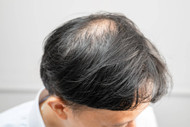The Science Behind Hair Thinning: What You Need to Know
Posted by Xandrox on 4th Jun 2025
Thinning hair can be an infuriating and emotional process for both women and men. It usually starts gradually—increasing hair on your brush, an expanding parting hairline or slowly receding hairline. Despite the fact that hair loss is astonishingly common, especially with age, many don't understand the biochemistry behind it. At XANDROX.com, we believe knowledge is power—especially when it comes to regaining control of your hair. Here's the tale.
What Does Cause Hair Thinning?
Hair thinning is caused by an interruption of your hair's growth cycle. Each hair on your head emerges from a follicle and experiences a cycle of growth (anagen), resting (telogen), and shedding (catagen). If this cycle is disrupted or shortened, your hair thins, and the follicles miniaturize—a process during which they reduce in size.
The Culprit: DHT
One of the most well-known causes of hair loss is dihydrotestosterone (DHT), a testosterone-derived hormone. While DHT is necessary for male development, in those who are genetically susceptible, it can also bind to hair follicles and reduce them, causing them to stop producing hair. This is the primary reason for androgenetic alopecia, or pattern baldness, in both men and women.
Other Common Causes of Hair Thinning
- Stress: Tension, either emotional or physical, may lead to follicles premature entry into the resting phase (a condition known as telogen effluvium).
- Deficiencies in Nutrients: Iron deficiency, vitamin D deficiency, and protein deficiency are known to harm hair negatively.
- Hormonal Disruptions: Thyroid disease, polycystic ovary syndrome (PCOS), or menopause can lead to thinning.
- Drugs: Some drugs like chemotherapy, anti-depressants, and antihypertensive drugs can result in hair loss.
- Scalp Disorders: Dandruff, psoriasis, and fungus infections can cause inflammation of the hair follicles, which results in thinning.
Is Hair Thinning Reversible?
The better news is—yes, in most cases, it is reversible or can at least be kept at bay with the right plan. The key is early treatment and using medications that attack the underlying problem, especially if DHT is the culprit.
How Xandrox Can Help
On XANDROX.com, we specialize in the latest, science-based hair regrowth treatments. Xandrox is a topical treatment that combines the proven potency of minoxidil with anti-DHT agents like azelaic acid to deliver a one-two punch against balding.
Here are the reasons Xandrox is the best:
- Blocks DHT at the follicle – halts miniaturization and stimulates full growth.
- Stimulates blood flow – minoxidil induces the relaxation of blood vessels within and around follicles, delivering more oxygen and nutrients.
- Clinically tested ingredients – every ingredient in Xandrox is chosen with performance and safety in mind.
If you catch the early warning signs of balding, don't wait. The sooner you act, the better your chances of re-growing thicker, more luscious locks.
Final Thoughts
Hair loss is common, but it doesn't have to be permanent. Educating yourself on the science behind what is occurring is what empowers you to take action. Whether you are suffering from early hair thinning or are already noticing tangible hair thinning, Xandrox is a precise, potent treatment that targets the source of the problem at its root—literally.
Ready to TAKE BACK your hair CONFIDENCE? Check out our full line of Xandrox products at XANDROX.com and FIND the solution FOR YOU.

